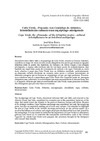Identificador persistente para citar o vincular este elemento:
https://accedacris.ulpgc.es/jspui/handle/10553/12816
| Campo DC | Valor | idioma |
|---|---|---|
| dc.contributor.author | Évora, José Silva | en_US |
| dc.date.accessioned | 2015-02-14T03:30:38Z | - |
| dc.date.accessioned | 2018-03-15T14:28:54Z | - |
| dc.date.available | 2015-02-14T03:30:38Z | - |
| dc.date.available | 2018-03-15T14:28:54Z | - |
| dc.date.issued | 2014 | en_US |
| dc.identifier.issn | 1133-598X | en_US |
| dc.identifier.uri | https://accedacris.ulpgc.es/handle/10553/12816 | - |
| dc.description.abstract | Descoberto entre 1460 e 1462, o Arquipélago de Cabo Verde, situado no Oceano Atlântico, constituiu ao longo de vários séculos, escala obrigatória dos navios que faziam as ligações atlânticas entre os portos das Américas, da Europa e da África Graças a sua situação privilegiada, o espaço cabo-verdiano não foi um mero ponto de reabastecimento, mas também um importante ponto de cruzamento de culturas e de raças. Pretende-se, neste texto, abordar o papel que Cabo Verde teve no Atlântico incidindo, particularmente, na dimensão cultural resultante do contacto entre povos e culturas provenientes de diferentes paragens que se fixaram no arquipélago ou que por aqui passaram. Procurar-se-á evidenciar não só a importância que Cabo Verde teve enquanto ponto de passagem obrigatória mas, sobretudo, as contribuições que mais marcadamente se denunciaram, isto é, os apports culturais que mais se acentuaram em Cabo Verde, como processos recebidos dos estrangeiros que por estas ilhas se cruzaram. | en_US |
| dc.description.abstract | The Archipelago of Cape Verde, discovered between 1460 and 1462, and situated in the Atlantic Ocean, had been considered for centuries one of the mandatory harbours of the ships that sailed across the Atlantic to the ports of America, Europe and Africa. Because of its strategic location, Cape Verdean anchorage was considered not only the supplying point, but also an important melting pot of races and cultures. It is intended to highlight the role of Cape Verde in the Atlantic focusing particularly on the cultural aspect, as a result of the influence of cultures and origins of people who had settled in or had passed by the archipelago. It is also aimed to underline the importance of Cape Verde as a mandatory gateway but, above all, to underline the remarkable contributions, such as the cultural “apports” by which Cape Verde were gripped, like processes brought by the foreigners who crossed these islands. | en_US |
| dc.format | es | |
| dc.language | por | en_US |
| dc.relation.ispartof | Vegueta: Anuario de la Facultad de Geografía e Historia | en_US |
| dc.source | Vegueta [ISSN 1133-598X], n. 14, p. 101-116, (2014) | en_US |
| dc.subject | 6301 Sociología cultural | en_US |
| dc.subject.other | Cabo Verde | en_US |
| dc.subject.other | Atlántico | en_US |
| dc.subject.other | Miscigenaçao | en_US |
| dc.subject.other | Crioulidade | en_US |
| dc.subject.other | Idiossincrasias | en_US |
| dc.subject.other | Cape Verde | en_US |
| dc.subject.other | Atlantic | en_US |
| dc.subject.other | Miscegenation | en_US |
| dc.subject.other | Race | en_US |
| dc.subject.other | Culture | en_US |
| dc.subject.other | Idiosyncrasies | en_US |
| dc.title | Cabo Verde, "Pousada" nos Caminhos do Atlântico. Interinluências culturais num arquipélago miscigenado | en_US |
| dc.title.alternative | Cape Verde, the «Pousada» of the Atlantico routes - cultural interinfluences in an interbred archipelago | en_US |
| dc.type | info:eu-repo/semantics/article | en_US |
| dc.type | Article | en_US |
| dc.compliance.driver | 1 | es |
| dc.identifier.absysnet | 234500 | - |
| dc.description.lastpage | 116 | en_US |
| dc.identifier.issue | 14 | - |
| dc.description.firstpage | 101 | en_US |
| dc.investigacion | Artes y Humanidades | en_US |
| dc.rights.accessrights | info:eu-repo/semantics/openAccess | es |
| dc.type2 | Artículo | en_US |
| dc.description.numberofpages | 16 | en_US |
| dc.utils.revision | Sí | en_US |
| dc.identifier.ulpgc | Sí | en_US |
| dc.description.esci | ESCI | |
| dc.description.dialnetimpact | 0,0 | |
| dc.description.dialnetq | Q4 | |
| dc.description.erihplus | ERIH PLUS | |
| item.fulltext | Con texto completo | - |
| item.grantfulltext | open | - |
| Colección: | Artículos Vegueta. n.14, 2014 | |
Los elementos en ULPGC accedaCRIS están protegidos por derechos de autor con todos los derechos reservados, a menos que se indique lo contrario.
